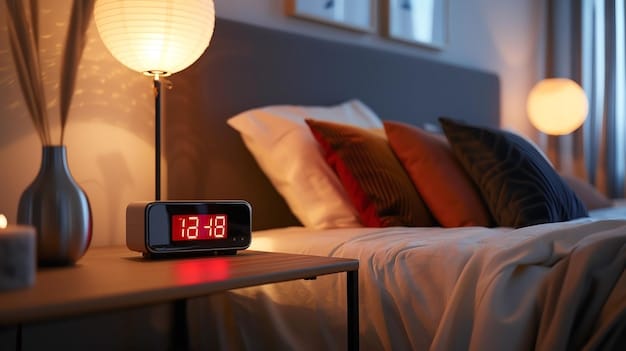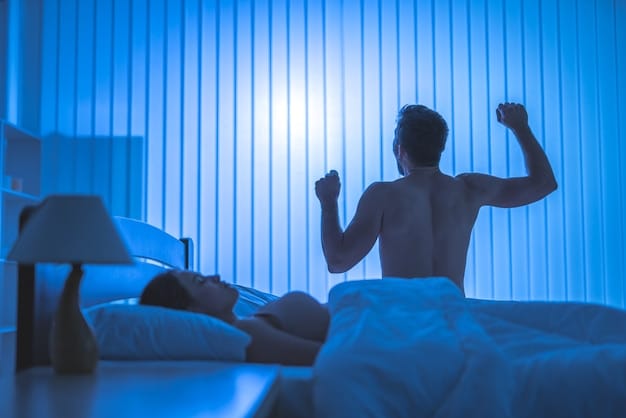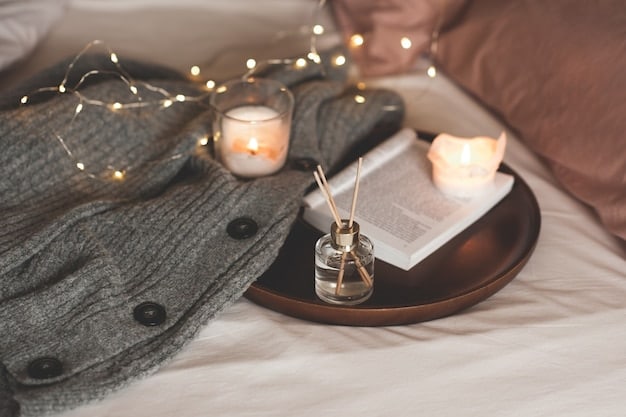Insider’s Guide: 5 Lesser-Known Ways to Improve Your Sleep Quality Tonight

Improving sleep quality extends beyond traditional advice, incorporating less common yet highly effective strategies like optimizing bedroom lighting, embracing strategic napping, and leveraging specific dietary adjustments for profound nightly rest.
In our fast-paced world, a truly restorative night’s sleep often feels like an elusive luxury. While common advice on sleep hygiene abounds, many individuals still struggle to achieve consistent, high-quality rest. This is where an insider’s guide: 5 lesser-known ways to improve your sleep quality tonight becomes invaluable, offering fresh perspectives beyond the typical recommendations.
The Power of Strategic Lighting: Beyond Blackout Curtains
While blackout curtains are a well-known tool for blocking unwanted light, the true art of strategic lighting for sleep involves more than just darkness. It’s about consciously managing your exposure to different light wavelengths throughout the day, particularly as evening approaches. Our bodies are exquisitely sensitive to light, and understanding how various light sources impact our circadian rhythm is key to unlocking deeper sleep.
The human eye contains photosensitive cells that detect light, sending signals directly to the suprachiasmatic nucleus (SCN) in the brain, our internal master clock. This clock regulates the sleep-wake cycle, primarily through the production of melatonin. Blue light, prevalent in electronic screens and modern LED lighting, is particularly disruptive because it signals daytime to the SCN, suppressing melatonin production. This suppression can delay sleep onset and diminish sleep quality.
Beyond Blue Light Filters: The Red Spectrum Advantage
Many are now familiar with blue light filters on devices, but few consider actively incorporating red-spectrum light into their evening routine. Red light, unlike blue, has minimal impact on melatonin production. Replacing bright overhead lights with dim, warm-toned (red or amber) lamps in the hours leading up to bedtime can significantly prime your body for sleep. This shift signals to your brain that night is approaching, facilitating a smoother transition into rest.
- Dim Red Nightlights: Use in bathrooms and hallways to avoid strong light exposure during nocturnal awakenings.
- Salt Lamps: Provide a soft, warm glow that is calming and melatonin-friendly.
- Smart Bulbs: Invest in smart lighting systems that allow you to program color temperature shifts, gradually dimming and warming as bedtime approaches.
Even subtle sources of light in the bedroom, such as indicator lights on electronics, can fragment sleep. Covering these with electrical tape or turning devices off completely eliminates these minor disturbances. The goal is to create an environment that signals safety and rest, free from any visual cues that might suggest it’s still daytime.
Understanding the nuances of light exposure goes beyond simply dimming the lights. It involves a holistic approach to your visual environment, recognizing light as a powerful hormone regulator that can either hinder or significantly enhance your journey to restorative sleep.
Optimizing Your Bedroom’s Thermal Environment: It’s Not Just About Temperature
The prevailing advice on bedroom temperature often centers on keeping it cool, typically between 60-67°F (15-19°C). While a cooler core body temperature is indeed conducive to sleep, the true optimization of your thermal environment extends beyond a simple thermostat setting. It involves understanding heat dissipation mechanisms and individual physiological responses to temperature variations.
Our bodies naturally experience a slight drop in core temperature as we prepare for sleep. A cool room facilitates this drop. However, excessive cold can be just as disruptive as excessive warmth, leading to muscle tension and difficulty relaxing. The ideal thermal environment creates a subtle, consistent coolness that supports, rather than forces, the body’s natural sleep processes.
Strategic Use of Bedding and Sleepwear
Beyond air temperature, the direct thermal interaction with your bedding and sleepwear plays a crucial role. Materials that wick moisture and allow for breathability can prevent overheating, even in a slightly warmer room. Conversely, layers can be added or removed to adapt to personal preferences and environmental shifts throughout the night. This dynamic approach allows for greater comfort and fewer sleep disturbances caused by feeling too hot or too cold.
- Natural Fibers: Opt for cotton, linen, or bamboo sheets and sleepwear for their breathability and moisture-wicking properties.
- Layered Bedding: Use multiple lighter blankets instead of one heavy duvet, allowing for easy adjustment.
- Cooling Pillows and Mattresses: Consider specialized bedding designed with cooling technologies to dissipate heat from pressure points.

Furthermore, external factors like humidity can impact perceived temperature. A dehumidifier in humid environments can make a room feel significantly cooler and more comfortable, even if the thermometer reading remains the same. The goal is to create a microclimate within your bed that is consistently comfortable and supportive of a stable core body temperature, empowering your ability to fall asleep and stay asleep with ease.
The Unconventional Nap: When and How to Recharge Without Ruining Night Sleep
Napping often gets a bad rap in sleep discussions, seen as a double-edged sword that can either refresh or disrupt. However, the unconventional nap is a finely tuned art, strategically employed to enhance alertness and cognitive function without cannibalizing nocturnal sleep. It’s about precision: timing, duration, and even the type of nap chosen can make all the difference.
Many believe that any daytime sleep sabotages nighttime sleep, but this isn’t universally true. For some, a well-timed, short nap can reduce accumulated sleep debt and significantly boost productivity and mood. The key lies in understanding your own circadian rhythm and typical sleep patterns to integrate napping beneficially.
The “Caffeine Nap” and the “Power Nap”
Two lesser-known napping techniques stand out. The “caffeine nap” involves consuming a small amount of caffeine (e.g., a cup of coffee) immediately before a 20-minute nap. Caffeine takes about 20 minutes to be absorbed and start taking effect. By napping during this window, you wake up feeling refreshed and the caffeine kicks in right as you emerge from sleep inertia, providing a powerful jolt of alertness.
- Caffeine Timing: Drink coffee immediately before lying down for your nap.
- Nap Duration: Set an alarm for 20-25 minutes to avoid entering deep sleep.
- Optimal Window: Best taken in the early afternoon, before 3 PM, to avoid interfering with nighttime sleep.
The “power nap” is simply a short nap, typically 10-20 minutes, designed to provide a burst of energy without leading to grogginess or difficulty falling asleep later. The critical element is to avoid entering deeper stages of sleep (slow-wave sleep), which can cause sleep inertia and make waking up feel worse than not napping at all. The aim is to stay in the lighter stages of sleep, primarily N1 and N2, allowing for mental refreshment without deep physiological rest.
The unconventional nap challenges the traditional view that all daytime sleep is detrimental. When approached with intention and an understanding of one’s own sleep biology, strategic napping can be a powerful tool for improving overall well-being and maintaining energy levels throughout the day, ultimately contributing to a more regulated and satisfying sleep-wake cycle.
The Olfactory Influence: Harnessing Scents for Deeper Sleep
Beyond visual and auditory cues, our sense of smell plays a remarkably powerful, yet often underestimated, role in influencing our sleep quality. The olfactory bulb, which processes smells, has direct connections to the amygdala and hippocampus – brain regions involved in emotion and memory. This direct pathway explains why certain scents can evoke immediate, strong emotional responses and, critically, induce states of relaxation or alertness.
While pleasant aromas are generally preferred, specific scents have been scientifically studied for their anxiolytic (anxiety-reducing) and sedative properties. Integrating these into your pre-sleep routine can create a powerful conditioned response, signaling to your brain and body that it’s time to unwind and transition into restful sleep.
Aromatherapy Beyond Lavender: Exploring Lesser-Known Calming Scents
Lavender is certainly popular for sleep, but other essential oils offer profound benefits. Vetiver, for example, has a deep, earthy scent that is grounding and known for its calming properties. Roman Chamomile is another excellent choice, prized for its ability to reduce tension and promote tranquility. Bergamot, a citrus oil, is known to reduce stress and anxiety, contributing to a more peaceful state of mind before sleep.
- Diffusers: Use an essential oil diffuser in your bedroom 30-60 minutes before bedtime.
- Scented Sachets: Place small sachets filled with dried herbs like valerian root or hops under your pillow.
- Pillow Mists: Create a diluted essential oil spray to mist your pillow and linens.

The regularity of scent exposure is as important as the scent itself. By consistently associating a particular aroma with your bedtime routine, you train your brain to anticipate sleep upon smelling that scent. This creates a powerful olfactory cue that can significantly deepen your relaxation and make the transition into sleep more seamless, transforming your bedroom into a sanctuary of scented tranquility.
Dietary Micro-Adjustments: Subtle Nutritional Hacks for Sleep
While broad dietary advice like avoiding caffeine before bed is common, subtle, targeted nutritional adjustments can have a surprisingly profound impact on sleep quality. These aren’t about drastic overhauls, but rather incorporating specific micronutrients and food compounds that support sleep-regulating neurotransmitters and hormones. It’s about optimizing your body’s internal chemistry for rest.
Sleep is a complex biological process influenced by numerous factors, including levels of serotonin, melatonin, and gamma-aminobutyric acid (GABA). Certain foods contain precursors to these compounds or nutrients that facilitate their production, offering a natural pathway to improved sleep without relying on supplements or medications.
Beyond Turkey: Tart Cherry, Kiwi, and Magnesium-Rich Foods
Many know about tryptophan in turkey, but consider the power of tart cherries. They are a natural source of melatonin and tryptophan, and studies suggest that consuming tart cherry juice can improve sleep duration and quality. Kiwis are another surprising sleep aid; research indicates that eating two kiwis an hour before bed can significantly improve sleep onset, duration, and efficiency, possibly due to their serotonin content and antioxidant properties.
- Tart Cherry Juice: Drink a small glass of unsweetened tart cherry juice an hour or two before bed.
- Kiwi Snips: Enjoy 1-2 kiwis as part of your evening snack.
- Magnesium-Rich Foods: Include foods like almonds, spinach, and avocados in your diet, as magnesium plays a crucial role in muscle relaxation and regulating sleep.
Furthermore, maintaining stable blood sugar levels throughout the night is crucial. A light, balanced evening snack that combines complex carbohydrates and protein can prevent blood sugar drops that might wake you up. Think a small handful of nuts with an apple, or whole-grain crackers with a slice of cheese. These small, consistent dietary adjustments collectively create an optimal internal environment, paving the way for deeper, more restorative sleep each night.
| Key Approach | Brief Description |
|---|---|
| 💡 Strategic Lighting | Manage light exposure, especially red-spectrum light, to optimize melatonin production. |
| 🌡️ Thermal Environment | Balance room temperature with breathable bedding for optimal core body temperature. |
| ☕ Unconventional Naps | Utilize “caffeine naps” or “power naps” for rejuvenation without disrupting night sleep. |
| 👃 Olfactory Influence | Incorporate specific calming scents beyond lavender into your pre-sleep routine. |
Frequently Asked Questions About Sleep Improvement
Scientific research supports the use of certain essential oils, like lavender and vetiver, for their anxiolytic and sedative properties. These scents can influence the limbic system, promoting relaxation and facilitating sleep onset and duration. While individual responses vary, the evidence suggests a tangible benefit beyond mere anecdotal reports.
Blue light, common in electronic screens, stimulates melanopsin cells in the eyes most strongly, signaling daytime to the brain and suppressing melatonin production. Red-spectrum light, conversely, has minimal impact on these cells. Incorporating warm, red-toned lights in the evening helps signal nighttime to your body, supporting natural melatonin release for better sleep.
For individuals with chronic insomnia, napping is generally discouraged, as it can reduce sleep drive at night and worsen the condition. However, for those without chronic issues, a short, strategic “power nap” (10-20 minutes) taken before mid-afternoon can be beneficial. It can boost alertness without significantly impacting nighttime sleep, provided sleep hygiene is otherwise consistent.
Key adjustments include consuming foods rich in melatonin (like tart cherries), serotonin precursors (such as kiwis), and magnesium (almonds, spinach). These nutrients support the body’s natural sleep-wake cycles and muscle relaxation. A balanced evening snack of complex carbs and protein can also help stabilize blood sugar, preventing nocturnal awakenings.
Beyond maintaining a cool room temperature (60-67°F), focus on bedding and sleepwear that allow for breathability and moisture-wicking. Natural fibers like cotton and linen help in regulating body temperature. Layering blankets provides flexibility. Addressing humidity with a dehumidifier can also enhance comfort and thermal regulation.
Conclusion
Achieving truly restorative sleep is a nuanced endeavor that often requires looking beyond conventional wisdom. By exploring and implementing these lesser-known strategies—from meticulously managing light exposure and optimizing your thermal surroundings to employing strategic napping, harnessing the power of specific scents, and making subtle dietary adjustments—you empower your body’s innate ability to rest deeply. These insider tips offer a holistic framework, leading not just to more sleep, but to sleep of genuinely higher quality, tonight and every night.





